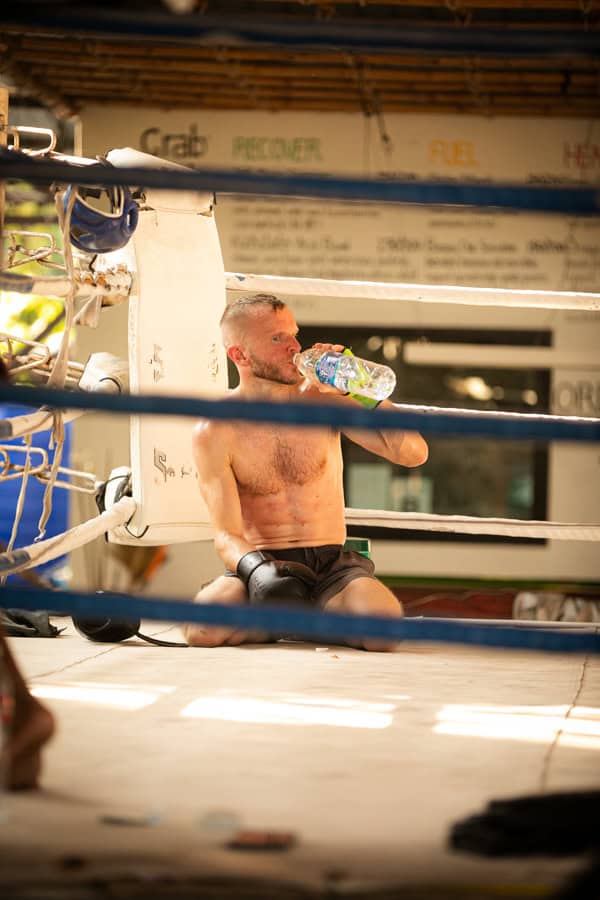
The Truth About Training in the Thai Heat: How to Adapt – Adjusting to Tropical Conditions
Thailand’s tropical climate is one of the biggest shocks to the system for visiting athletes. Whether you’re a seasoned Muay Thai fighter or a first-time gym-goer, training in the Thai heat can be brutal – but also transformative.
At Sumalee Boxing Gym, based in Phuket, we see it every week: new arrivals melting on the mats, struggling to breathe through the humidity, and questioning their decision to train in a literal sauna. But within a few days, the body begins to adapt – and with the right knowledge and approach, you can thrive in the heat.
This guide will help you understand what’s happening to your body, how to adapt safely, and why training in tropical conditions can elevate your performance to a whole new level.
1. Why the Heat Feels So Brutal at First
Thailand’s climate is defined by high humidity and temperatures averaging 30–36°C (86–97°F). Add intense physical exertion to that, and you’ve got the perfect recipe for dehydration, reduced performance, and slower recovery.
The main culprits?
- High humidity slows sweat evaporation (your body’s cooling system).
- UV exposure from outdoor training increases core body temperature.
- Electrolyte loss from profuse sweating can lead to cramps and fatigue.
If you’re coming from cooler climates, your body isn’t acclimated to this level of heat stress. It takes time – and strategy – to adjust.
2. The First 7 Days: How to Survive the Shock
Most people acclimatise within 7–10 days of consistent training. During this time, you’ll notice your body:
- Begins sweating earlier and more efficiently.
- Retains more sodium and fluid.
- Recovers faster between sessions.
Tips for surviving the first week:✅ Train early or late – Book your sessions for early morning or late afternoon when temperatures are cooler.
✅ Hydrate relentlessly – Sip water before, during, and after training. Add electrolytes like sodium, potassium, and magnesium.
✅ Reduce training intensity – Don’t go all-out on day one. Listen to your body and build gradually.
✅ Stay cool between sessions – Use cold towels, fans, or take a dip in the pool at our on-site accommodation.
“You’re not being weak by pacing yourself in the heat – you’re being smart.” – Coach Keng, Head Trainer at Sumalee
3. Nutrition Tips for Hot-Weather Training
What you eat matters even more when training in the heat.
Eat light, eat often. Heavy meals slow digestion and raise core temperature. Aim for:
- Cooling fruits (pineapple, watermelon, mango)
- Thai-style broths and soups
- Lean protein and whole carbs for energy recovery
Stay salty. You’ll lose a lot of sodium through sweat, so don’t shy away from salting your food or sipping on electrolyte drinks throughout the day.
Our on-site café offers hydration-friendly options including coconut water and post-training smoothies.
4. Train Smarter, Not Harder
Adjusting your training schedule to Thailand’s heat doesn’t mean sacrificing intensity – it means being strategic.
Use the Heat to Your Advantage:
- Increased calorie burn: Your body works harder to cool itself, leading to higher energy expenditure.
- Improved cardiovascular function: Heat adaptation enhances blood plasma volume and heart rate recovery.
- Mental toughness: Training in tropical conditions builds serious grit and mental resilience.
At Sumalee, our coaches tailor each session to the climate and your level. Our open-air ring, shaded training areas, and ice bath recovery help balance the extremes.
5. Rest and Recovery: Your Secret Weapon
In tropical climates, rest is not a luxury – it’s a requirement.
🔥 Sleep in an air-conditioned room, such as the ones we have on-site.
🔥 Take a nap post-training to speed up recovery.
🔥 Use cold exposure: try ice baths included in our recovery-focused Gold+ package.
🔥 Try yoga or mobility sessions in our on-site Yoga Shala.
6. Common Mistakes to Avoid
🚫 Ignoring dehydration signs – Headaches, cramps, and brain fog are early signs. Don’t push through them.
🚫 Overtraining in week 1 – This leads to burnout, injuries, and mental fatigue. Ease in.
🚫 Skipping electrolytes – Water alone isn’t enough in tropical heat. Use sachets or tablets regularly. We supply Wilder electrolytes in some packages and at our Pro Shop
🚫 Underestimating sun exposure – Always wear sunblock, a hat, and sunglasses when walking or running outside.
7. Heat-Proof Gear Tips
Wearing the wrong gear makes everything worse. Opt for:
- Lightweight, sweat-wicking clothing (avoid cotton)
- Training towels to wipe down frequently
- Flip-flops for around the gym – your shoes will get soaked
- Cooling sleeves or hats for outdoor runs (UV resistant is an even better choice)
Pro tip: Buy Muay Thai shorts and gear locally – they’re designed for this climate. Check out our on-site pro shop when you arrive.
8. Final Thoughts: Embrace the Heat, Don’t Fear It
Training in Thailand’s heat is a rite of passage for many fighters. It’s tough, yes – but it’s also incredibly rewarding.
Once you adapt, you’ll be fitter, leaner, and more mentally resilient than you ever imagined. And with the right support, like what we offer at Sumalee Boxing Gym in Phuket, the process becomes not just manageable – but enjoyable.
Want to train with us in Thailand?
Check out our all-inclusive Muay Thai Training Packages and get ready to conquer the tropical challenge head-on.
External Links for Further Reading:



